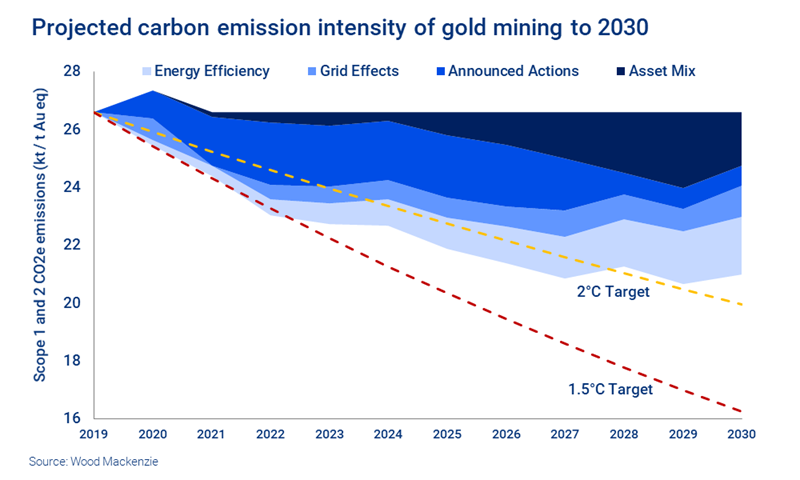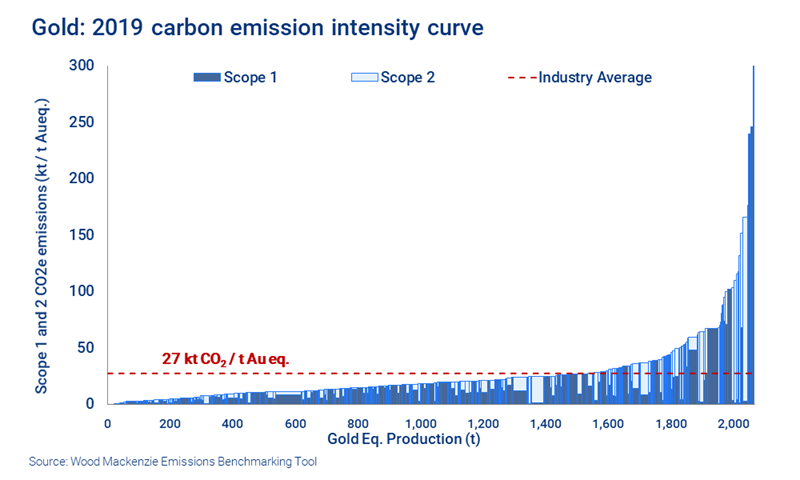Based on its scale, gold mining could be considered relatively inconsequential in terms of total global greenhouse gas emissions. But the industry cannot afford to be complacent. Scrutiny of the environmental impact of mining has never been greater and with COP26 on the horizon the spotlight will only intensify. Miners not striving to reduce their carbon footprint are likely to lose favour with investors and struggle to secure project financing.
So, how is the gold industry tackling the challenge?
Read on for our view. You can also fill in the form to access a complimentary insight from our gold experts: Informal gold mining: time to become formal?
What is the carbon footprint of the gold industry?
For the purpose of our analysis, we looked at 339 large-scale gold mines, or 60% of total gold supply. We excluded small-scale, informal, artisanal or illegal mining due to the opaque nature of supply, as well as gold production originating from primarily copper, zinc and nickel mines. By this definition, in terms of direct Scope 1 and 2 emissions, we estimate the gold industry emitted over 55 Mt of CO2 equivalent (CO2e) in 2019, or approximately 0.2% of total global carbon emissions.
Gold miners are not resting on their laurels. Implemented or planned cleaner energy projects are expected to deliver savings of over 3Mt CO2e per year, a 5.5% reduction on the industry’s total 2019 emissions. That is equivalent to removing approximately 654,000 cars from the roads.
This figure doesn't include overarching company-level ambitions for carbon neutrality where no defined plan is in place. If we assume such targets are developed and met then the planned clean energy projects in our dataset can be viewed as just the start of the journey.
Certainly, the motivation is there. Evidence suggests cutting carbon emissions is far more than just a box-ticking exercise – several miners, including Polymetal and Newmont, have executed sustainability-linked credit facilities over the past year.
Gold miners’ actions to address their carbon emissions are far from inconsequential, then. The question remains, though, as to whether the transition to cleaner power alternatives is fast enough.
Is the ‘greening’ of gold moving fast enough?
We used our emissions benchmarking tool to assess the pace of decarbonisation in the industry. The chart below plots the forecast progress of gold miners in reducing emissions intensity to 2030 against the reductions required to align with 2 °C and 1.5 °C climate target scenarios.
Based on this analysis, gold miners look broadly on track to align with the 2°C climate target – which limits the rise in global temperatures since pre-industrial times to 2 °C by the end of this century. However, more action is required if the industry is to meet the 1.5 °C climate target, let alone surpass it.
The population of assets in operation are expected to be an important determining factor in reducing emissions, with several carbon-intensive mines due to go offline before the end of the decade. However, in the past 12 months, the elevated gold price has been accompanied by mine life extensions materialising at companies like Equinox and Yamana.
Ultimately, if mine life extensions continue, we will need to see even more aggressive action to reduce emissions to align with targets.
Not all gold emissions are equal
When defining the ‘gold standard’ of decarbonisation it’s not enough to look only at absolute emission reductions, we need to consider them in context.
For example, a mine already sourcing its power from Hydro-Quebec is unlikely to be able to make as big a reduction in emissions as a mine currently sourcing its power from diesel generators. In contrast, if your starting point is very high compared to peers, then naturally by extension you have more room to make bigger cuts.
The carbon emission intensity curve below allows us to compare mines’ emission intensity with their peers in the same way as we would compare their cost-competitiveness. As you can see, relative emissions intensity varies considerably and some mines have a lot more ground to cover than others.
Barriers to cross on the road to greener gold
Mines beholden to carbon intensive grids could struggle to significantly improve their emissions performance over the near-term – unless the process to approve onsite renewable alternatives speeds up markedly.
Roger Baxter, CEO of Minerals Council South Africa, has been vocal in petitioning the government there to simplify the administrative framework for self-generated electricity. Given that several South African mines sit at the upper end of the carbon curve, this could be a game changer for emissions intensity – not to mention the reliability and power cost benefits. Hopefully, the recent approval of the 40 MW solar plant at South Deep is just the start.
Companies under mounting pressure from shareholders to expedite the shift toward cleaner energy may find the path of least resistance is to dispose of certain assets. The risk of companies disposing of assets, as opposed to investing in reducing emissions, is that it is simply displacing the problem rather than resolving the issue. The perception of the industry could be tarnished by the continued existence of these ‘dirtier' assets.
What’s certain is that the focus on carbon emissions in the gold sector is here to stay. Whilst cleaner energy projects are coming thick and fast, the bulk of progress so far has come from just 15 companies; to change the perception of the industry there is going to have to be more of a collective effort. At a time when other asset classes, such as cryptocurrency, are having their sustainability drawn into question, there is a real opportunity for gold miners to boost their green credentials.
If you’re interested in accessing detailed information and analytics about the gold mining sector, visit our gold research suite. And fill in the form at the top of the page for a complimentary copy of our recent insight: Informal gold mining: time to become formal?







